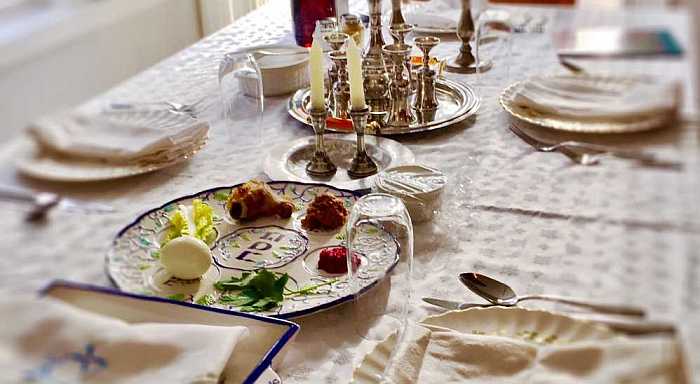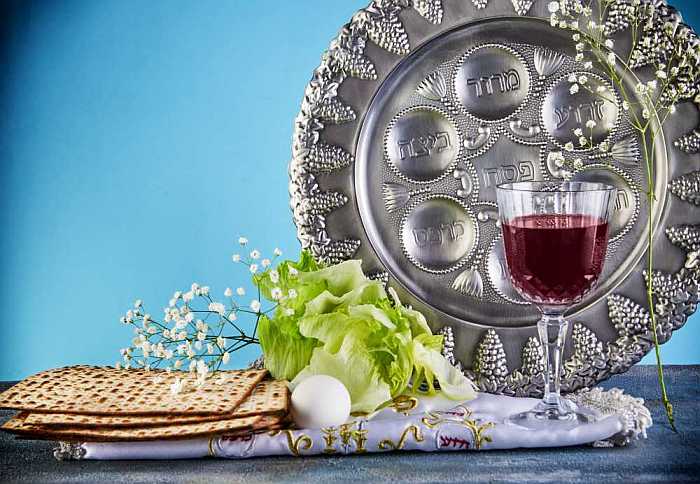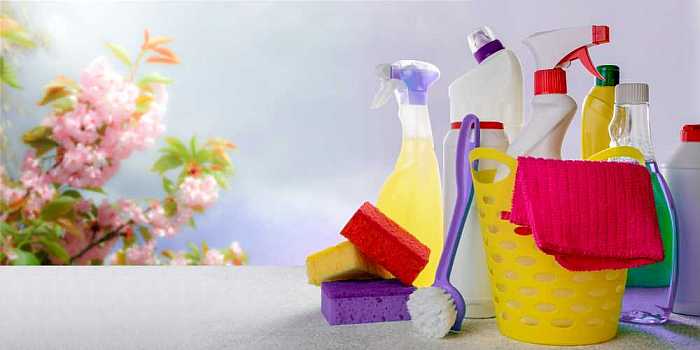
Pesach Seder (Envato)
When Is Passover 2026?
When Is the Seder?
How do Jews celebrate Passover?
Clean the House

The Seder and Haggadah
Why do People go away for Pesach?
Passover (Pesach in Hebrew) is one of the most widely observed Jewish holidays—and one of the most recognizable. Even if you've never celebrated it yourself, you may have seen the section in your local supermarket marked “Kosher for Passover” that appears each spring, especially in areas with large Jewish communities.
Many people have Jewish friends or coworkers and may have attended a Seder, the ceremonial meal held on the first night (or two) of the holiday. Still, we often receive questions about the origins of the holiday, the meaning behind its customs, and what makes Passover food different. This guide is here to help clarify the basics.
Passover commemorates the biblical story of the Exodus, when the Israelites were freed from slavery in Egypt. It’s rich in symbolism, ritual, and tradition—especially around the Seder table and the foods that are eaten (or avoided).
When Is Passover 2026?
According to the Jewish calendar, which is a lunar calendar, Passover (Pesach) begins on the 15th of the Hebrew month of Nisan. In Israel, it ends on the 21st of Nisan, and outside of Israel, it ends on the 22nd of Nisan. While the Hebrew dates never change, the Gregorian (secular) calendar shifts from year to year. The holiday always falls during the spring season—hence the name “Chag Ha’Aviv”, or “Spring Festival”. Pesach usually falls in April, though it occasionally starts in late March.
In 2026, Passover begins on Wednesday night, April 1st and ends:
- on Wednesday night, April 8th in Israel, and
- on Thursday night, April 9th outside of Israel.
The holiday always begins on the same Hebrew date, no matter where you live. But how long the holiday lasts—and whether you have one or two Seders—depends on your location.
We now follow a fixed calendar, but during the time of the Temple, the new moon was declared monthly by witnesses, and the message had to be delivered across distances. It was difficult to get word to the Jews living in galut (the Diaspora) quickly, so there was a risk of celebrating on the wrong day. To avoid confusion, Jews in the Diaspora celebrated two days to cover both possibilities. This led to a rabbinic decree, over 2,000 years ago, that communities outside of Israel would continue to observe two-day holidays for Passover, Shavuot, and Sukkot. This extra day is called “Yom Tov Sheni Shel Galuyot.”
When Is the Seder?
In Israel (“minhag yoshvei Eretz Yisrael”), there is one Seder, held on the first night of the holiday. The first and seventh days are Yom Tov—no work permitted. The five days in between are Chol Hamoed, when limited work is permitted.
Outside of Israel (“minhag galuyot”), there are two Seders—one on the first night and another on the second night. The first two days and the last two days are Yom Tov. The middle four days are Chol Hamoed.
When Is Passover in the Coming Years?
- Passover 2026: April 1–9
- Passover 2027: April 21–29
- Passover 2028: April 10–18
- Passover 2029: March 30–April 7
- Passover 2030: April 17–25
For more details on upcoming dates and holiday length in Israel vs. the Diaspora, check out our full blog post: When is Passover? Dates for 2026, 2027, and Beyond
How do Jews celebrate Passover?
Passover commemorates the Exodus of the Jewish people from Egypt after more than 400 years of slavery. It’s a holiday filled with tradition and meaning, celebrating the many miracles that occurred during the Exodus, including the Ten Plagues and the parting of the Red Sea.
One of the most well-known observances is avoiding chametz—any food made with leavening agents like bread, pasta, or anything that contains fermented grain. This custom comes from the story of the Israelites leaving Egypt in such a hurry that their dough had no time to rise.
Instead of chametz, Jews eat matzah, a flat, unleavened bread that serves as a central symbol of the holiday. Throughout the week of Passover, Jewish families eat Kosher for Passover foods—which are made without chametz and often with special supervision. You’ll see these products show up in stores as early as February in many Jewish communities.
From cleaning the house to remove chametz, to preparing special meals and gathering for the Seder, Passover is a time of remembrance, storytelling, and celebration. And while many customs are shared across communities, there are also beautiful differences depending on where in the world Jews are celebrating. Explore unique Passover traditions from around the world.


Intense cleaning for Pesach
Clean the House
Think spring cleaning—but on steroids. In the weeks leading up to Passover, Jewish households do a deep clean to remove all traces of chametz (leavened products like breadcrumbs, cereal, or that lone cracker hiding behind the couch).
The kitchen gets special attention. Ovens and stovetops are scrubbed, cabinets are emptied and wiped down, and dishes that were used during the year are often swapped out for Passover-only ones or thoroughly kashered.
But it’s not just the kitchen. Every room of the house is cleaned—especially in homes with kids (or teens who snack in their rooms even though they know they’re not supposed to, but that’s another story). Closets, backpacks, car seats, under the beds—no crumb is left behind.
Every family has its own customs and levels of stringency when it comes to Passover cleaning. Some go all out, while others keep it practical and focused.
Before Pesach—whether you start a week before or the day before, depending on your personality—you need to “turn over” your kitchen. That means switching out your regular dishes, pots, cutlery, and appliances for special ones used only during Passover. Year-round kitchenware gets boxed up and stored away. Some people still cover their countertops, but many now rely on pouring boiling water over them as part of the kashering process.
Before Pesach—whether you start a week before or the day before, depending on your personality—you need to “turn over” your kitchen. That means switching out your regular dishes, pots, cutlery, and appliances for special ones used only during Passover. Year-round kitchenware gets boxed up and stored away. Some people still cover their countertops, but many now rely on pouring boiling water over them as part of the kashering process.
Need help figuring out what really needs to be cleaned—and what doesn’t? Check out our guide: Passover Cleaning Made Simple

Guide to Pesach traditions
The Seder and Haggadah
Passover begins on the first night with the Seder, a ritual meal that’s both deeply meaningful and highly family-oriented. Most Jews around the world—regardless of their level of observance—celebrate Pesach with a Seder, often surrounded by extended family and friends.
The traditional Seder includes matzah, four cups of wine, and a Seder plate filled with symbolic foods that represent both the bitterness of slavery and the miracle of the Exodus. The Seder plate usually includes:
- A shankbone
- A hard-boiled egg
- Bitter herbs
- Romaine lettuce
- Charoset (a sweet mixture of fruit and nuts)
- A vegetable (like parsley, celery or potato) for dipping in saltwater
These symbolic foods are eaten at specific points throughout the Seder as the story of the Exodus is told.
Central to the evening is the Haggadah, the book that sets the structure for the Seder—what to say, when to drink the wine, when to eat the matzah, and how to tell the story of leaving Egypt. Every family might follow the same basic format, but no two Seders are exactly alike. The Haggadah acts as both a guidebook and a storytelling tool, and it's full of meaning, commentary, and tradition.
There are over 3,000 versions of the Haggadah—some traditional, others playful or themed (yes, even Harry Potter and Marvel Haggadahs exist). There are Haggadahs for kids, those featuring rabbinic commentary, versions in multiple languages, and editions that reflect different Jewish customs from around the world.
► Learn more about the history and importance of the Passover Haggadah.
► Learn more about the history and importance of the Passover Haggadah.
The Haggadah begins with the early days of the Jewish people—Abraham, Isaac, and Jacob—and walks us through the story of the Israelites going down to Egypt, becoming enslaved, and then redeemed through miracles like the Ten Plagues and the splitting of the Red Sea. There are songs and tunes along the way, and depending on where in the world your family is from, you might share melodies that span continents.
Once the story is told and the symbolic foods have been eaten, it’s time for the meal. And just when you think you’re done, there’s more singing, some afikoman searching, and a beautiful close with the hopeful words:
“Next year in Jerusalem.”
► Read more about what happens at the Passover Seder and how the evening is structured.
► Read more about what happens at the Passover Seder and how the evening is structured.
 Pesach vacations on the beach
Pesach vacations on the beach
What do People do for Passover Vacation?
The first two days and the last two days of Passover (only the first and last days in Israel) are similar to Shabbat—no work, no electronics, and no travel. The days in between are called Chol Hamoed, which are like the weekdays of the festival, when limited work is permitted and outings are encouraged.
Many families use this time for fun day trips to local zoos, museums, parks, or amusement parks. The weather is usually great—it is spring after all—and schools are on break, so it’s an ideal time for family outings.
While some families stay home and plan activities nearby, others join organized Passover programs around the world. These programs combine holiday observance with hotel stays, food, entertainment, and excursions. It’s become a popular way to enjoy the holiday—without all the cleaning and cooking.
Why do People go away for Pesach?
As mentioned earlier… Passover prep is intense.
Before the holiday even begins, there’s deep cleaning, shopping for all new Kosher for Passover food, and switching over the kitchen—which means putting away your everyday pots, pans, dishes, and utensils and pulling out your Passover ones. And that’s all before you even start cooking for the Seders and the rest of the week’s meals.
Tired yet?
That’s exactly why many families choose to go away for Passover. What started decades ago with New Yorkers heading to Catskills hotels has turned into a global trend. First it spread to places like Miami and Israel, and now there are Passover programs across the United States, Europe, Mexico, South Africa, Dubai, Panama, Morocco, South America, and beyond.
Many of these programs take place at beautiful resorts and are all-inclusive: gourmet food, Seders, minyanim, lectures, kids’ programming, entertainment, and excursions. Some guests use Passover as a time to relax by the pool, while others use it to explore a new country.
There’s truly something for everyone, and while some programs are very luxurious, there are also budget-friendly options available.
Final Thoughts
This blog is meant to be a basic introduction to the holiday of Passover and the growing world of Pesach vacations. There’s much more to learn about the laws and customs of the holiday, which vary across Jewish communities.